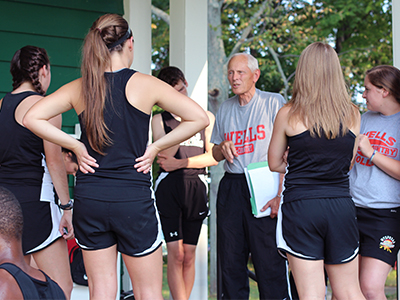
Finger Lakes Times: Wells Gets A Legend To Coach Cross Country
Dr. Jack Daniels, the Head Coach of the Wells College men's and women's cross country teams, was featured in a recent issue of the Finger Lakes Times. The full feature story, written by Scott Porter, is below.
Last March, Wells College hired the "World's Best Running Coach" for its cross country teams. That was the title bestowed on Jack Daniels by Runner's World editor Amby Burfoot 20 years ago.
Calling someone the "World's Best" is always subjective. However, when I ask a high school track and field or cross country coach the method by which they train their kids, the answer, more times than not, is Jack Daniels.
I first heard his name around 1990 when my brother, Jason, was running track and field and cross country at SUNY Cortland. Daniels was his coach. Jason had been a decent runner at West Genesee, but he blossomed under Daniels' tutelage. By the time he graduated, he held the school record in three indoor events, the 800, 1,000 and 1,500 meters, was a Division III All-American. Jason later was inducted into the SUNYAC Cross Country Hall of Fame.
During Daniels' 17-year tenure at Cortland, his teams won eight national titles, yet it did not look like a national program — 90 percent of its runners came from a 130-mile radius in central New York. I didn't know just how important Daniels was to the running community until I bought his book, Daniels' Running Formula, as a training guide for my first marathon five years ago.
While the science underlying his formula is difficult for dunces like me to grasp, you don't need to be an Einstein to apply it. First published in 1998, his book introduced runners to the world of VDOT. Through his research and testing, Daniels assigned aerobic profiles to runners of all stripes to determine their maximum aerobic potential.
For example, the formula allows a runner to extrapolate from her 5K race time how long it will take her to run a marathon. Based on her 5K performance, the runner is assigned a VDOT value that, when she trains for the marathon, can be used in conjunction with a training chart dictating what pace to run when running easy, tempo or intervals.
The formula is not reserved for any one kind of runner. It is egalitarian. Every runner can determine the best pace based on his or her ability. Nor is the training destructive on the body. It is better running through science.
Daniels' accomplishments transcend his book. Here is a partial account: Korean War veteran; 1956 silver and 1960 bronze team medalist in pentathlon (five sports consisting of running, swimming, fencing, pistol shooting and equestrian); TV commentator at the Montreal Olympics; a doctorate in exercise physiology; various coaching gigs; including Peru's National Coach; and working with a vast assortment of elite athletes like Jim Ryun and Joan Benoit Samuelson.
Daniels, who wrote his doctoral dissertation on the effects of high altitude on runners, left Cortland about 10 years ago to take a position at Northern Arizona University's High Altitude Training Center in Flagstaff. After the university closed the training center in 2009 due to a lack of funding, Daniels took a coaching job at Brevard College in North Carolina.
His predecessor at Wells, Julie (Donnelly) Bailey, ran for Daniels at Cortland and recommended him for the cross country position at Wells. His wife, Nancy, will be his assistant coach. They have bought a house that Daniels says is the oldest in Cortland, built in 1815; Cortland is 34 miles from Aurora.
Daniels' return to the Finger Lakes is a coming home of sorts. He and his wife raised their two daughters in Cortland. His time there cuts against the grain of an otherwise nomadic life. It seems he has been everywhere: born in Detroit, growing up in San Francisco, service in the U.S. Army, education degrees from Montana and Wisconsin, studying in Sweden, coaching in Oklahoma and Texas, working for Nike in New Hampshire and Oregon.
Daniels' biggest challenge at Wells will be to find enough boys to field a decent program. The pool is small. The school, which has about 500 undergraduates, became coed in 2005. Its gender breakdown is one male for every two females.
Whoever runs for Daniels will leave Wells a better, smarter runner. Apropos of my brother's experience, Daniels says that he gets as much enjoyment watching a young runner improve one's performance than seeing one of his runners make it to the Olympics.
In addition to his coaching, consulting and guest appearances in academic and running circles, Daniels is an associate professor at Arizona School of Health Science's Human Movement Program: He teaches online.
Earlier this year, Daniels retested 23 of the 26 elite athletes he tested 45 years ago for his dissertation. He intends to publish his findings in a scientific journal. And, he is working on the third edition of his book.
In case you're wondering, Daniels is 80. He figures it will be 10 to 15 years before he retires.








